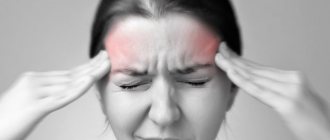Causes
Why does my head hurt? Common causes of headaches are:
- neck muscle spasm;
- compression of the vessels of the head and neck;
- compression of the membranes of the brain;
- brain nutritional disorders: insufficient blood supply, narrowing of blood vessels supplying the brain;
- smoking, poisoning with alcohol, drugs, medications;
- stress, sleep disturbance;
- due to neck and head injuries;
- birth injuries;
- anomalies in the development of blood vessels in the neck and head.
Primary headaches
| Name | Symptoms |
| Migraine | Throbbing pain in the head, most often occurring after sleep. The severity of the headache ranges from moderate to unbearable. The pain is felt on one side of the head: in the right or left temple, forehead, crown. Migraine lasts up to three days, often accompanied by nausea and vomiting. A person does not tolerate bright light and loud sounds. Migraines can be caused by stress, insomnia, or changes in weather. The tendency to migraine is inherited. |
| Tension headache (TTH) | A pressing headache covers the entire head or separately the back of the head, crown, forehead. Cephalgia can be severe. A tension headache attack can last up to 7 days. At the same time, my head hurts every day. TTH occurs due to emotional or physical stress. |
| Cluster headache | Unbearably strong shooting pain in the head. It is felt on one side, in the forehead and eye area. Cluster pain causes redness and swelling of the face and lacrimation on the pain side. Due to a severe headache, a person behaves restlessly. |
| Headache and facial pain due to trigeminal neuralgia | Very strong short-term stabbing pain in the head. The pain is felt in the crown, forehead, and can affect the face and teeth. The headache attack lasts several hours. In this case, spasm of the facial muscles may occur. |
2. Symptoms and diagnosis
In addition to the pain syndrome, facial pain can be accompanied by a number of disorders that can help identify the causes. However, it should be borne in mind that these manifestations may be a reaction to the pain itself (an attempt to compensate for an unpleasant condition) and not be signs of certain diseases. Facial pain may be accompanied by the following disorders:
- facial asymmetry;
- muscle tension;
- swelling of the nose and runny nose;
- itching, swelling, redness of the skin;
- nervous tics;
- impaired sensitivity to smells, loss of taste;
- decreased visual acuity;
- increased body temperature;
- tearfulness;
- dry mouth or eyes;
- noise in ears.
The pain itself can be shooting, dull, aching, localized or migrating, radiating to other parts of the head, neck, back
.
“aura”
may be observed - a state when the perception of the surrounding reality is distorted (from altered smells to visual images at the edges of the visible area).
If facial pain is accompanied by a feeling of “heat,” nausea, and pulsation of blood vessels, then the cause of the pain may be an exacerbation of hypertension.
Sometimes the face hurts in combination with numbness in areas of the skin. These symptoms may indicate a stroke, vegetative-vascular dystonia, cervical osteochondrosis, and neuropsychic disorders.
When pain is accompanied by phenomena characteristic of certain diseases, diagnosis should be aimed at confirming or excluding the suspected diagnosis. However, quite often even a thorough examination does not reveal obvious causes of facial pain. In this case, they talk about “atypical facial pain”
. Presumably, its nature lies in the plane of neurological and mental disorders. Such pain can recur throughout life, and at different periods with different frequencies. Most likely, stress and other conditions of modern life disrupt the production of certain neurotransmitters, which affects the skin, blood vessels, nerve conduction and excitability in the facial area.
When visiting a doctor with facial pain, the following diagnostics may be prescribed:
- examinations aimed at identifying trigeminal neuralgia;
- assessment and localization of muscle soreness;
- examination of the skin and mucous membranes (often a herpetic infection of the nose can cause facial pain);
- measurement of intraocular and intracranial pressure;
- radiography, MRI and CT to detect diseases of bones, gums, teeth;
- general blood test (to identify inflammatory diseases by the level of leukocytes and ESR).
Visit our Neurology page
Secondary
Secondary headaches can be a sign of other diseases. Most often it is caused by the following diseases:
| Cause of headache | Manifestations of the disease |
| Cervical osteochondrosis | Headache appears with a sharp turn of the head, prolonged neck tension, or an uncomfortable position of the head during sleep. The pain intensifies in the morning, often spreading to one side of the head. May be accompanied by hearing loss in one ear, tinnitus, and spots before the eyes. |
| Flu or cold | The headache is not very severe, localized in the forehead, eyes, temples on one or both sides. In addition to the headache, the patient’s temperature rises above 37 degrees, a runny nose, cough, sore throat and other cold symptoms appear. |
| Increased intracranial pressure | Prolonged frequent headaches are combined with nausea and vomiting. A person often feels sick in the morning. If these symptoms and mild headaches occur, you should consult a doctor. |
| Brain concussion | The headache may last for several years after the injury. Accompanied by anxiety, irritability, decreased concentration, and dizziness. The person may suffer from depression. |
| Vegetovascular dystonia | Causes dizziness, nausea, neurotic disorders, and surges in blood pressure. Exacerbations occur with weather changes and emotional overload. |
| Hypertonic disease | A bursting headache is felt in the back of the head. Combined with heat in the head, dizziness, noise in the head, spots before the eyes, staggering. A person may feel nausea and heart pain. |
| Sinusitis, sinusitis, sinusitis | Chronic long-term pressing headaches in the forehead, eyes, cheeks. Accompanied by nasal congestion, runny nose, and slight fever. |
| Horton's headache | Characterized by attacks of severe boring pain. It spreads around the eye, temple and forehead. The attacks usually occur at the same time. This type of headache is more common in men. |
| Hypertonic disease | A bursting headache is felt in the back of the head. Combined with heat in the head, dizziness, noise in the head, spots before the eyes, staggering. A person may feel nausea and heart pain. |
Possible causes of headache on the right side
Pain in the right side of the head can occur due to various diseases and conditions. It is important to understand that it sometimes manifests itself in a healthy person and does not always indicate any violations. It can be sharp or aching, concentrated only on the right side of the head or spread over its entire surface, radiating to the neck, arms, shoulders or back.
The simplest causes of headaches on the right include physiological factors that periodically occur in every person.
- Stressful situations are one of the most common reasons for a headache on the right side. They are accompanied by the release of adrenaline into the bloodstream, which constricts blood vessels and causes an increase in blood pressure. Doctors at the Clinical Institute of the Brain recommend avoiding stress and ensuring proper rest, otherwise there is a risk of developing chronic hypertension.
- Excessive physical activity is another cause of pain on the right side of the head. After training or a busy day at work, characteristic signs appear: accelerated heartbeat, pain and discomfort in the chest, difficulty breathing. These are dangerous symptoms that indicate the need for rest.
- Bad habits can cause headache attacks on the right side. Smoking and alcohol abuse quickly worsen the condition of blood vessels and affect the functioning of the heart, reducing the speed of blood circulation in the brain. Atherosclerosis, hypertension and other diseases, as well as increased risks of stroke and heart attack can be a consequence of an unhealthy lifestyle.
- Coffee, tea, and energy drinks not only tone up, but also affect the condition of blood vessels. They narrow, which can lead to an attack of hypertension, rapid pulse and acute pain in the right side of the head.
At home, you can lead a healthy lifestyle, choose healthy foods and exercise. Taking care of the state of the cardiovascular system and physical training, as well as getting enough sleep and regular rest will help avoid pain in the right side of the head. However, during diagnosis, more serious causes of headaches in the right hemisphere may be detected - they require complex treatment, which can be obtained at the Clinical Brain Institute.
Migraine
Migraine is an attack of headache, usually one-sided. The exact cause that causes it remains unknown, but a hereditary predisposition has been found. Migraines can also appear in adulthood as a result of injuries, falls, concussions, and vascular diseases. During an attack, the patient has a headache on the right or left, and general health, performance, and concentration deteriorate. Often the overall picture is preceded by a “migraine aura” - a set of characteristic symptoms that can be used to determine the imminent onset of acute pain. These include:
- nausea, vomiting;
- increased sensitivity to bright lighting, tearing eyes;
- feeling of numbness, trembling of the hands;
- deterioration of hearing and vision.
A headache in the right hemisphere of a migraine can spread over the entire surface of the head, and also spread to the arms, neck and shoulders. The attack can last from several hours to several days. According to statistics, migraines occur more often in women. Painkillers will help reduce symptoms, but after their effect wears off, the pain returns.
Intracranial pressure
Intracranial pressure is represented by several types of fluids, including blood and the contents of the cerebral ventricles, as well as the brain. It is impossible to measure this value at home, and the diagnosis is made based on characteristic symptoms:
- headache in the right hemisphere, back of the head or temples - it is acute, throbbing, and can spread to the entire surface of the head;
- pain in and behind the eyes;
- nausea and vomiting, general deterioration of health.
With increased intracranial pressure, pain on the right side of the head radiates to the temples and often has a girdling character. Its intensity depends on the cause of hypertension. This symptom can appear one-time, due to stress, strain, or lack of oxygen in the room. Frequent attacks of headaches in the right side of the head, which are associated with pressure, require more detailed diagnosis and may indicate cerebral circulatory insufficiency.
Cluster headaches
Cluster headaches are the rarest, but at the same time the most intense type. Their exact cause is unknown. This type of pain in the right area of the head is accompanied by additional symptoms:
- drooping of the upper eyelid;
- difficulty breathing, shortness of breath;
- redness of the skin, sweating;
- lacrimation in one or both eyes, pain, increased sensitivity to light.
Acute pain in the head on the right, left, or along its entire surface lasts for 5–10 minutes, then it becomes less intense and persists for several hours. Cluster pain can occur daily, over a long period of time (several months) at specific times.
Headache on the right side due to tonsillitis
Infectious tonsillitis (tonsillitis), as well as other viral and bacterial colds, can cause headaches on the right side. It is often one-sided and appears in the half on which the inflamed tonsils are located. The patient also exhibits additional symptoms common to influenza, ARVI and other colds:
- temperature increase;
- general weakness, muscle aches;
- swelling in the throat and pain;
- nasal congestion.
A characteristic sign of tonsillitis is enlarged tonsils. This results in a severe sore throat and difficulty swallowing. White spots or plaque may be visible on them - foci of bacterial purulent infection.
Injuries and their consequences
An acute headache on the right side of the head can occur with a severe injury or fall. Bleeding from the vessels that supply the brain provokes the formation of hematomas, which put pressure on the nerve tissue. Symptoms of a traumatic brain injury may vary depending on the location of the injury and the severity of the impact:
- sharp pain in the head on the left or right side, in the temples or on the back of the head;
- impaired coordination of movements;
- incomprehensible speech, unusual behavior;
- visual defects: swelling, changes in head shape, wounds;
- nausea, vomiting, fainting;
- pain on the right side of the head radiates to the ears.
Traumatic brain injuries cannot be treated at home. They can lead to memory loss and other dangerous complications. If the right side of your head hurts due to a strong blow, it is recommended to consult a doctor immediately.
Concussion
A fall or blow can also cause a concussion. This is a disruption of its functioning that causes loss of consciousness, and in some cases short-term amnesia. If the concussion occurs on the right side, it is accompanied by pain in the right hemisphere of the head, nausea, dizziness, blurred vision and hearing, and loss of coordination. Painful sensations can persist for a long time and recur in the future, in response to physical activity, weather changes and other factors.
Stroke
Stroke is an acute disorder of cerebral circulation. This is a dangerous condition that requires emergency medical attention and poses a threat to the patient's life. The most common type is ischemic stroke. It occurs when there is insufficient oxygen supply to the brain. Its causes may be obstruction or compression of the arteries, low intracranial pressure, blood clots and other factors in which the flow of blood to the nerve tissues is stopped. It can be determined by the following characteristics:
- sharp pain in the head on the right or left;
- impaired coordination and symmetry of movements, deterioration of memory and attention;
- redness, pallor or blueness of the mucous membranes;
- muscle paralysis, decreased sensitivity of the skin in one part of the body.
A stroke occurs suddenly, but sometimes an attack can be recognized several hours before it worsens. At risk are men and women over 50 years of age with chronic heart and vascular diseases. An attack can also be triggered by excess weight, abnormalities of the arteries and atherosclerosis, irregular work hours and lack of rest, as well as bad habits: smoking and alcohol abuse.
The cause of a headache on the right or left, which occurs suddenly and is of high intensity, may be a hemorrhagic stroke. It is more dangerous to human life because it is a hemorrhage into the cerebral ventricles or the spaces between the membranes. An attack occurs when an artery supplying the brain ruptures and in most cases leads to loss of consciousness. The main task in case of hemorrhagic stroke is to seek emergency help as quickly as possible, but this does not guarantee a positive outcome.
Neoplasms
One of the causes of pain on the right side of the head is brain tumors, so it is always worth undergoing additional examination if this symptom occurs frequently. The danger is that the pain may not be too intense even with large or fast-growing tumors. Then they intensify, appear more often and become more acute. In addition, doctors at the Clinical Brain Institute recommend undergoing periodic examinations regularly - tumors in the initial stages may not cause pain or other symptoms.
Neck diseases
In the neck area there are important vessels that feed the brain and saturate its cells with oxygen. With some injuries and diseases, the movement of blood through the vessels becomes difficult, which is accompanied by headache attacks. There are several disorders that are often diagnosed in patients with chronic pain in the right side of the head:
- osteochondrosis is a disease of the intervertebral discs associated with a violation of their nutrition, in which the cartilage tissue becomes less elastic and elastic;
- protrusion - protrusion of intervertebral cartilage, often in the lateral direction (hernia is the terminal stage of protrusion);
- curvature of the spine - scoliosis of the cervical spine causes disruption of the blood supply to the brain;
- displacement of individual vertebrae is the result of injuries or weakness of the muscles of the cervical spine.
For pain in the neck that radiates to the head and arms, it is important to undergo an examination. X-rays will show the affected areas, type and stage of the disease. Based on these data, the doctor decides on the method of treatment.
Chronic paroxysmal hemicrania
Another cause of headaches on the right side of the head is chronic paroxysmal hemicrania. This is a rare autonomic disorder in which severe unilateral headaches are combined with other symptoms (nausea, photophobia, constriction of the pupils, drooping of the upper eyelid). Sharp pain in the right side of the head is often located in the temples. An acute attack lasts on average 10 minutes, but its duration can range from 5 to 40 minutes. During an exacerbation of the disease, up to 40 attacks per day can occur, in most patients - up to 5 to 10.
Meningitis
Pain in the head on the right side from above, in the temple or back of the head, which over time becomes acute and spreads over its entire surface, may be the first sign of meningitis. This is a dangerous infectious disease that affects the meninges and requires timely comprehensive treatment. The disease can be determined by the results of laboratory tests, as well as by characteristic signs:
- pain in the right side of the neck and head;
- nausea, vomiting;
- temperature rise to high levels;
- impairment of memory, consciousness, concentration;
- reduction of pain sensitivity;
- Herpes may appear in the mouth and other mucous membranes.
Meningitis can cause dangerous complications even if promptly diagnosed and treated. Nerve cells damaged as a result of infection propagation are not restored, and areas of necrosis appear in the membranes and cortex of the brain. The clinical picture differs depending on the location and size of the affected area. These may be mental, motor or sensory disorders, nervous tics and other complications, developmental delays in children. Cases of death cannot be ruled out either.
Costen's syndrome
Costen's syndrome is a rare, specific disease that is caused by dysfunction of the temporomandibular joint and jaw. It can appear only on the left or right side, as a result of which the pain will also be one-sided. Patients complain of typical symptoms:
- the right side of the head, arm and half of the neck hurts - symptoms intensify during exacerbation of the disease and decrease during periods of remission;
- fatigue, soreness, crunching while chewing;
- pressing pain on the right or left, which manifests itself during active and passive movements in the temporomandibular joint, as well as when pressing on this area;
- limited jaw movements, the patient is unable to open his mouth wide.
Patients with Costen syndrome often have additional symptoms caused by the underlying disorder. Thus, changes in bite, bruxism, one-sided abrasion of dental surfaces, and incorrect placement of teeth in the oral cavity are characteristic.
When you can't put off visiting a doctor
- For an acute headache that suddenly arose and resembles “a blow to the head.” This may be a symptom of subarachnoid hemorrhage. Call an ambulance immediately.
- The pain intensifies when lying down and goes away half an hour after getting out of bed. This is a sign of impaired outflow of cerebrospinal fluid, increased intracranial pressure, and a tumor.
- If the headache appears regularly, is intense, is associated with changes in body position and changes with movement.









